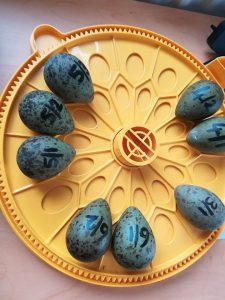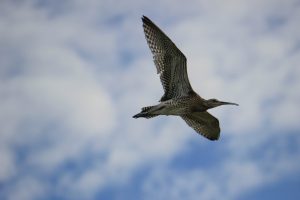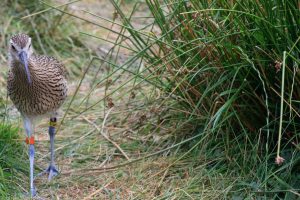 During the 2018 breeding season the focus has shifted from previous work conducted by Curlew Country. Having trialled headstarting a small number of chicks in 2017, the project was granted a Natural England licence to take 50 curlew eggs to incubate, rearing the resulting chicks to the point of fledging. The decision to make headstarting a priority this year was not taken lightly and is seen as a way of boosting the population numbers which are not being replenished through natural nesting attempts.
During the 2018 breeding season the focus has shifted from previous work conducted by Curlew Country. Having trialled headstarting a small number of chicks in 2017, the project was granted a Natural England licence to take 50 curlew eggs to incubate, rearing the resulting chicks to the point of fledging. The decision to make headstarting a priority this year was not taken lightly and is seen as a way of boosting the population numbers which are not being replenished through natural nesting attempts.
The headstarting process has been a steep learning curve for the project, with many trials and tribulations to overcome, you can read more about this in project assistant Amber’s blog on our website, https://curlewcountry.org/2018/07/16/unexpected-duties/. We did not expect all of the eggs to be successful, and of the 50 collected a number of these did not hatch, due to either infertility or complications during the incubation process. Others were lost as chicks, some having deformities when born, such as drooping wings or curled in feet. Three clutches of pipping eggs were returned to natural nests, but all subsequently lost, presumed predated. However, 21 chicks have successfully been reared through to fledging stage, with a proportion of these have just been released into the wild.
Release Day

On Friday the 20th July the first of the Curlew Country chicks were released into the wild. It was a difficult decision to make. Ideally we would have preferred the ground to be wetter from rainfall before releasing the chicks to ensure that food was not too difficult to find. The ages of the chicks ranged between 5 and 7 weeks old, and they were frequently flying when the pen was entered. It was decided that it couldn’t wait any longer, as they had begun to hit the sides of the pen in alarm when approached, and we couldn’t risk them damaging themselves.
A soft release was conducted, with the end of the pen being deconstructed, allowing them to find their own way out to explore. Most of the chicks simply walked out into the long rush pasture near their enclosure, however the last chick to leave did so with tremendous style, taking flight and calling in large circles above our heads.

After some initial exploration, some more of the chicks decided to test their flying skills and took to the sky with great confidence. The following chicks were a little more cautious, making short hopping flights, eventually getting airborne but with a slight wobble and uncertainty. In one tense moment we witnessed one chick take off but misjudge its landing, crashing into some tall vegetation. A quick reaction from Tony the field ornithologist reassured us that the bird was okay, with only its pride showing some damage. Others similarly flew well, but were not so sure about landing. Some chicks remained in the fields foraging in their new-found pasture, hunting for insects and invertebrates completely naturally. Seeing them so readily take to their natural behaviours was a great relief for all the Curlew Country team and its hard-working volunteers. After watching for a while to ensure that all the chicks were adapting well, the small assembly of onlookers retreated and left them to their own devices.
The soft release format means that food and water has been kept available close to the pen, for the chicks to use if they choose. This will slowly be reduced, until they can manage to forage for enough food on their own. A few of the chicks have been seen in the days following the release but on the whole they have dispersed which offers us encouragement that they will do well within the wild.
What happens next?

All of the reared chicks have been fitted with colour rings with a unique two letter code. This allows them to be re-identified by other birders if the code is read. If you spot a colour ringed curlew, you can report the sighting to Tony Cross, Curlew Country ornithologist, by e-mail tony.cross@virgin.net, alternatively you can report the sighting online via the BTO website.
We do not expect to see the chicks returning until 2020, as they spend a year at their winter roosts until they reach breeding condition. We hope that by releasing them in good suitable habitat, at least some of the chicks will return to nest in similar types of habitat, but only time will tell.
Ideally we would have liked to GPS tag some of the chicks to find out where they went after release. Sadly due to their flighty nature and the confined space, catching the chicks to affix a tag would endanger the birds too greatly. In future years we hope to find a method in which this can be done more efficiently.
 The final small group of chicks are not yet at fledging stage, so cannot be released. In the next couple of weeks they will be released at a suitable site along the migration route, with plenty of foraging habitat and water available to them.
The final small group of chicks are not yet at fledging stage, so cannot be released. In the next couple of weeks they will be released at a suitable site along the migration route, with plenty of foraging habitat and water available to them.
For more information…
You can also follow us on twitter, @CurlewCountry, or on facebook, @CurlewCountryPage.
To get in touch please e-mail curlewcountry@gwct.org.uk or phone the office on 01743 296100.
